
Benicia State Recreation Area is a state park unit of California, United States, protecting tidal wetland. It is located in the Solano County city of Benicia, 2 miles (3.2 km) west of downtown Benicia and borders Vallejo's Glen Cove neighborhood. The park covers 447 acres (181 ha) of marsh, grassy hillsides and rocky beaches along the narrowest portion of the Carquinez Strait. Southampton Creek and the tidal marsh front Southampton Bay, where the combined waters of the Sacramento and San Joaquin Rivers approach San Pablo Bay, the northern portion of San Francisco Bay.
Hawaiian hibiscus are seven species of hibiscus native to Hawaii. The yellow hibiscus is Hawaii's state flower. Most commonly grown as ornamental plants in the Hawaiian Islands are the non-native Chinese hibiscus and its numerous hybrids, though the native Hibiscus arnottianus is occasionally planted.

Armeria maritima, the thrift, sea thrift or sea pink, is a species of flowering plant in the family Plumbaginaceae. It is a compact evergreen perennial which grows in low clumps and sends up long stems that support globes of bright pink flowers. In some cases purple, white or red flowers also occur. It is a popular garden flower and has been distributed worldwide as a garden and cut flower. It does well in gardens designed as xeriscapes or rock gardens. The Latin specific epithet maritima means pertaining to the sea or coastal.
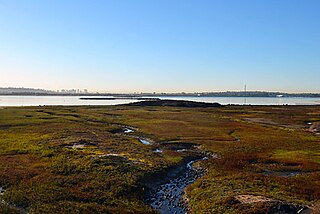
California's coastal salt marsh is a wetland plant community that occurs sporadically along the Pacific Coast from Humboldt Bay to San Diego. This salt marsh type is found in bays, harbors, inlets, and other protected areas subject to tidal flooding.

The Lanphere Dunes National Natural Landmark a unit of the Humboldt Bay National Wildlife Refuge Complex, is located in Humboldt County, California. The dune complex consists of the wave slope, fore dune, herbaceous and woody swales, coniferous and riparian forest, freshwater swamp, freshwater marsh, brackish marsh, salt marsh, and intertidal mudflats. The site exemplifies dunes succession.

Arctostaphylos glandulosa, with the common name Eastwood's manzanita, is a species of manzanita.

Chloropyron maritimum is a rare species of flowering plant in the family Orobanchaceae native to western North America. It is known by the common names saltmarsh bird's beak and Point Reyes bird's beak, depending on the specific subspecies.
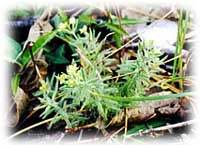
Galium californicum is a species of flowering plant in the coffee family known by the common name California bedstraw.

Cordylanthus rigidus is a species of flowering plant in the family Orobanchaceae known by the common name stiffbranch bird's beak.

Clarkia tembloriensis is a rare species of flowering plant in the evening primrose family, known by the common name Temblor Range clarkia and belonging to the Onagraceae family.

Chloropyron palmatum is an endangered species of salt-tolerant, flowering plant in the family Orobanchaceae. It is a low, highly branched herbaceous annual with each flower enclosed by a single, characteristically palmate bract. It is known by the common names of palmate salty bird's-beak and palmate-bract bird's-beak.

Limnanthes floccosa, or woolly meadowfoam, is a species of meadowfoam found in Northern California and Southern Oregon, in the United States. Most of the subspecies have highly restricted distributions and are listed as critical or endangered.
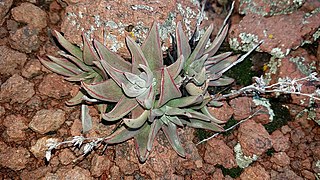
Dudleya abramsii is a species complex of succulent plants native to California and parts of Baja California. There are numerous subspecies, some critically endangered, with varying habits and lifestyles, but most often characterized by a smaller size, yellow flowers, and an affinity for rocky habitats. The subspecies may be polyphyletic.

Monardella linoides is a species of flowering plant in the family Lamiaceae known by the common name flaxleaf monardella.
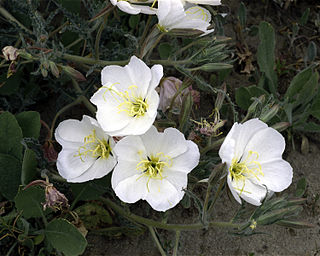
Oenothera deltoides subsp. howellii, the Antioch Dunes evening primrose, is an endangered subspecies of plant in the family Onagraceae, genus Oenothera, and species Oenothera deltoides.

Sidalcea calycosa is a species of flowering plant in the mallow family known by the common names annual checkerbloom, checker mallow, and vernal pool checkerbloom.
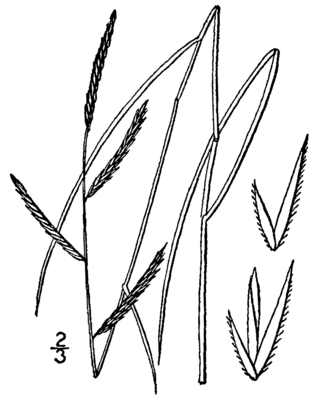
Sporobolus pumilus, the saltmeadow cordgrass, also known as salt hay, is a species of cordgrass native to the Atlantic coast of the Americas, from Newfoundland south along the eastern United States to the Caribbean and north-eastern Mexico. It was reclassified after a taxonomic revision in 2014, but the older name, Spartina patens, may still be found in use. It can be found in marshlands in other areas of the world as an introduced species and often a harmful noxious weed or invasive species.
The San Diego National Wildlife Refuge Complex is a series of wildlife refuges established by the United States National Wildlife Service beginning in 1972. The complex incorporates five refuges in San Diego County and Orange County in California.
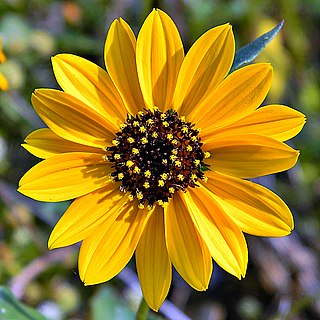
Helianthus debilis is a species of sunflower known by the common names cucumberleaf sunflower, beach sunflower, weak sunflower, and East Coast dune sunflower. It is native to the United States, where it can be found along the Atlantic and Gulf Coasts. It is known elsewhere as an introduced species, such as South Africa, Australia, Taiwan, Slovakia, and Cuba.

Hooks Island is an uninhabited, approximately 36-acre (15 ha) tidal salt marsh island in San Francisco Bay, in Palo Alto, California, United States. In the 2010s, it was observed to be a home for tens of near-endangered California clapper rails.



















